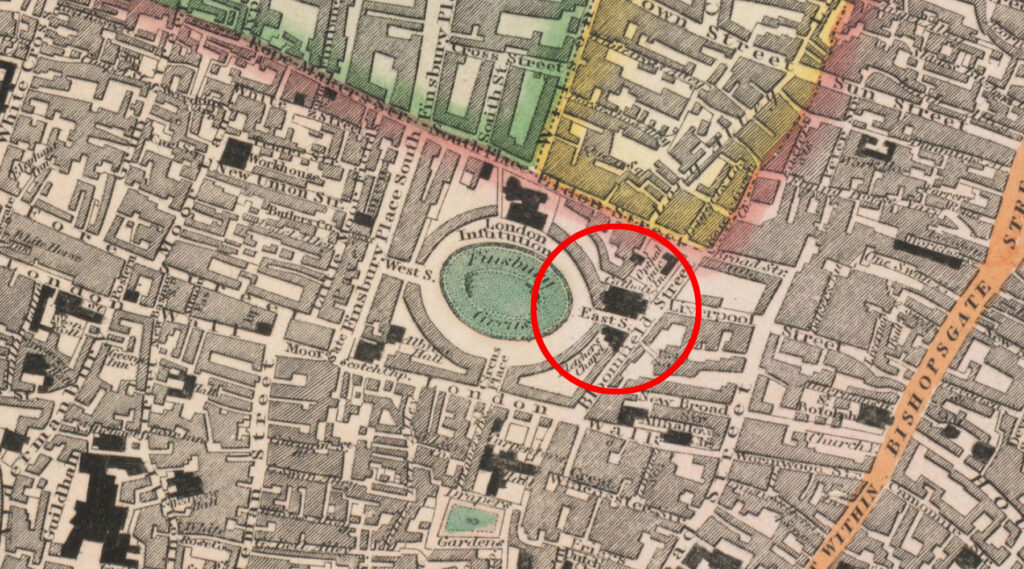Just around the corner from Liverpool Street station is a building that if glanced at briefly looks like a conventional Edwardian office block, but is in fact the City of London’s only Roman Catholic Church.
It’s been on this site since 1903, but has a history that can be traced back to 1686 when a Catholic chapel was opened not far from here, but it had to close just a few years later following the Glorious Revolution, and Catholic worship went somewhat underground. Following the Catholic Relief Act of 1791, Catholics were permitted to worship in public, and in 1820, a large Catholic Chapel was built in the newly created Finsbury Circus.
As probably the most important Catholic church in the UK at the time, by 1836 it boasted a congregation of 30,000 people.
It was granted the status of Pro-Cathedral in 1850, when the Catholic hierarchy was re-established in the UK, but the title passed to a Kensington based church in 1869 as the City’s population was by then shrinking. Such a large church was however becoming a burden to a shrinking population, and in 1899, it was decided to sell the building.
Some reports say the church was demolished to make way for the Metropolitan Railway, but that was built in 1875. In fact, it was a simple matter of mammon at work — they sold the church to a commercial property developer for the considerable sum of £201,000 – half of which went to support the construction of Westminster Cathedral, and the rest for a smaller church to be built locally. This wasn’t an easy thing to do though, as there was a principle that consecrated sites could not be sold for secular purposes, and a decision by the Congregation of Cardinals in Rome upheld that policy. The church appealed to Pope Leo XIII, and he overruled the decision, allowing the church to be sold.
Before the church was demolished though, some 5,000 bodies were in the catacombs under the church, and had to be moved to a burial ground at the end of Waverly Avenue in Wembley, now known as St Joseph’s Cemetery next to St Joseph’s Catholic Infant School.
The church closed at the end of September 1899
A few years later, on 25th March 1903, the replacement church — the current one — opened in nearby Eldon Street. The church exterior is obviously a church when you look at it, although a casual glance would probably not notice that the decorative features are Christian in nature.
The four panels show the Annunciation, the Nativity, the Deposition and the Assumption, and above these is a statue of the Virgin and the Christ Child, crowned by cherubs.
The church itself is set back a bit from the road, behind the two shops and a small office block above the entrance. The doubled doors, lead down some steps to a sunken church, reputedly lowered to deal with ancient light protection issues with their neighbours, and through a couple more doors into the main church.
Although much smaller with a capacity for 400 people, internally it was designed to look very similar to its demolished larger predecessor.
An old stained glass window had been conserved and was reinstalled here, although, the church is doesn’t have any external windows, so this one is backlit by electric lights. Rather cleverly, as the church is surrounded on all sides, daylight comes in from a row of windows in the curved ceiling.
The marble apse columns, altar and font were brought from the old church and incorporated in the church, by the prolific architect, George Sherrin. The church is also noted for its organ, which was brought from the old church, and is thought to be over 200 years old.
However, when the church was built, it wasn’t in the City of London, so how is it now described as the only Catholic Church in the City?
The church used to be sited within Hackney, but the redrawing of boundaries in April 1994 (pdf) saw the City of London expand to swallow up the Broadgate office development, which was being built at the time, but sat half-and-half between the City and Hackney boroughs. As part of the cleaning up of that problem, the north side of Eldon Street, including the Catholic Church became part of the City of London.
That makes it, probably, the first Catholic church in the City of London for some 300 years, and only thanks to a bureaucratic change of election boundaries, otherwise the City could still be, officially at least, free of Papist worship.












What about Ely Place with its catholic church..you are wrong
Ely Place is in Camden.
Great article about a the RC St Mary Moorfields, I had no knowledge that it existed, and it was interesting to learn that the funds from the sale of the church contributed significantly to construction of Westminster Cathedral. For anyone interested, the Wikipedia article abpit the church has an image of the grand front entrance, an interior photo showing the scale of the nave facing the alter, and of the church organ:
https://en.wikipedia.org/wiki/St_Mary_Moorfields
Oh I love borough boundaries and little tidbits of funky changes like this! I love to point out and bore my boyfriend with change of borough signs when we’re out and about.
The rooms above the entrance, facing Eldon Street are not, in fact, “a small ofice block”, but the Presbytery, where the clergy of the Church live.
“the church is noted for its organ”… MAYBE many years ago. I have played it and it is total crap.